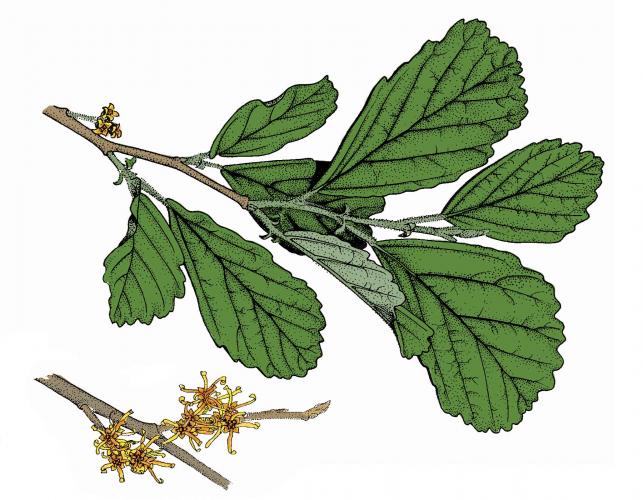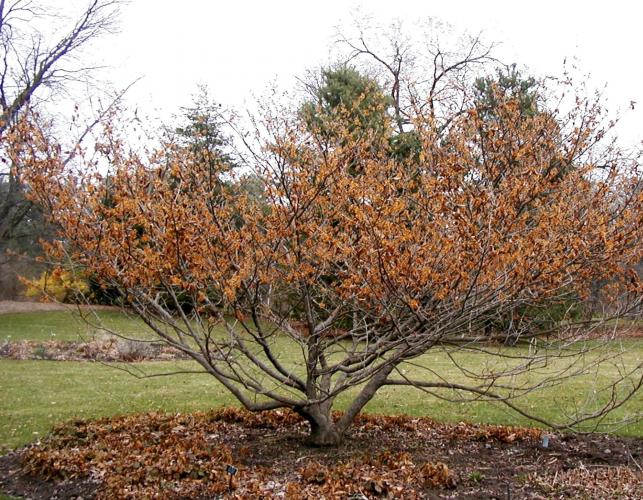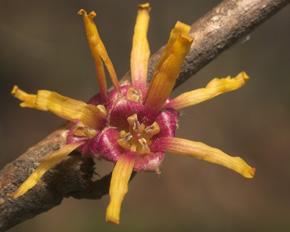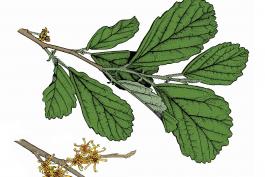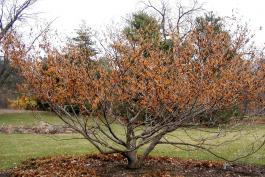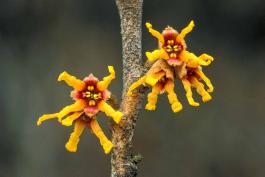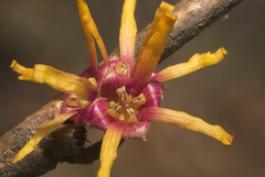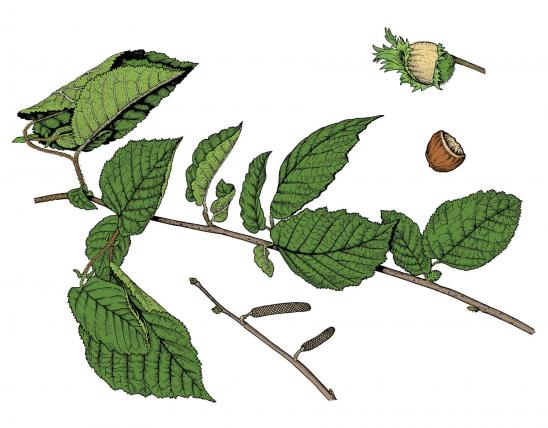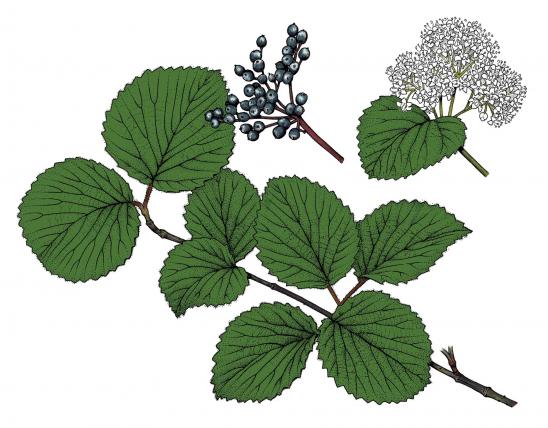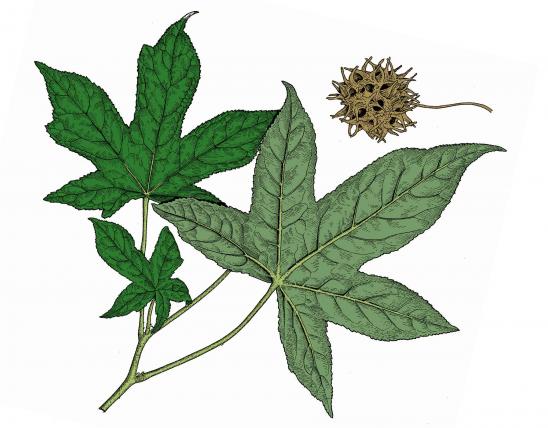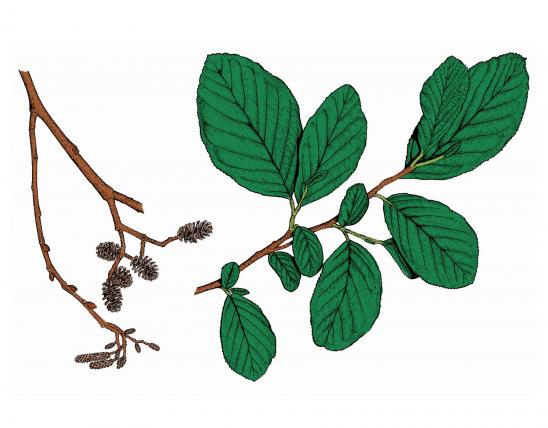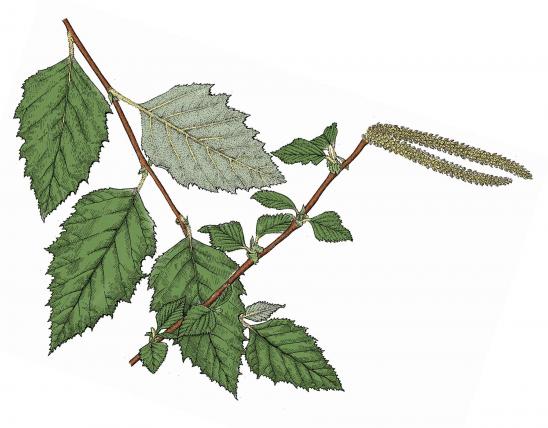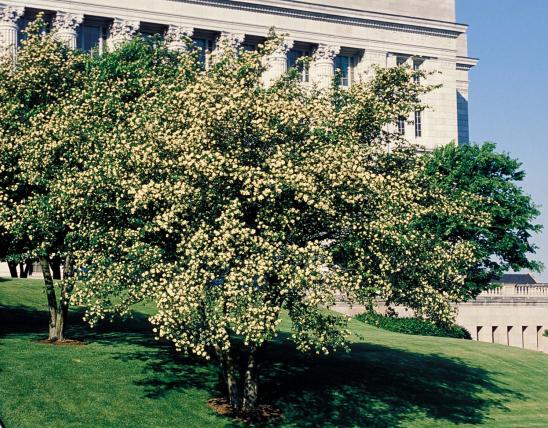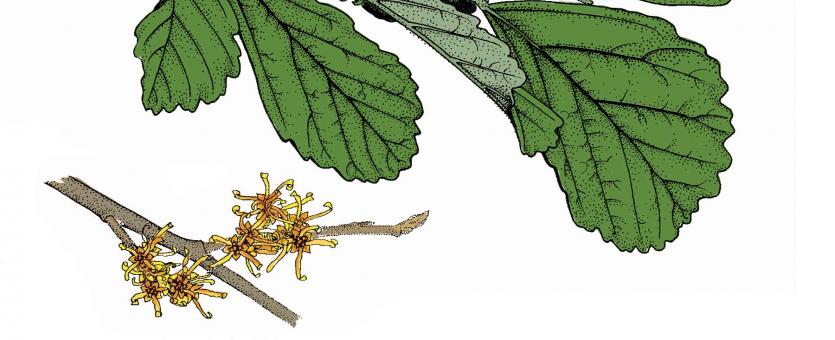
Ozark witch-hazel is a shrub, often sending up sprouts from the base, or (less commonly) a small tree (especially in cultivation).
Leaves are alternate, simple, 2–5 inches long, inverted egg-shaped to oval, tip blunt or rounded, base wedge-shaped to rounded, uneven; edges wavy to almost lobed above the middle; dark green above, with veins lying below the surface, paler below, with veins prominent. Leaves turn brown in autumn and tend to stay on the tree through winter.
Bark is tight, not peeling; gray to brown, often with gray blotches, pores narrow, cream-colored.
Twigs are rather stout, light brown to reddish-brown or gray, densely velvety-hairy, later smooth and light or dark gray.
Flowers January–April (rarely in December), clustered or solitary, fragrant; petals 4, orange to dark red (rarely yellow), narrow, ribbonlike or straplike, only to a little more than ½ inch long.
Fruits September–October; a hard, woody, elliptical capsule ½ inch long, splitting down a 2-parted tip/ending in 4 sharp, curved points. Capsule pops open, forcibly discharging seeds to a distance of up to 30 feet. Seeds large, hard, black, 1 or 2 per capsule.
Similar species: Eastern witch-hazel, also called American or common witch-hazel (H. virginiana), has a wider range in eastern North America, but it has a more limited distribution in our state. It is scattered in Missouri's eastern Ozarks, with a disjunct population in Barry County. It flowers earlier, in November–December (rarely as early as September); the flowers are yellow (not orange to dark red) and the petals are slightly longer (to ¾ inch). The leaves are strongly uneven at the base, with one side being straight and the other side being rounded to heart-shaped. Its leaves tend to fall off in autumn.
Note that additional species are available in cultivation, including Chinese (H. mollis) and Japanese (H. japonica) witch-hazels, plus a variety of hybrid cultivars.
Height: to 10 feet; spread: to 8 feet.
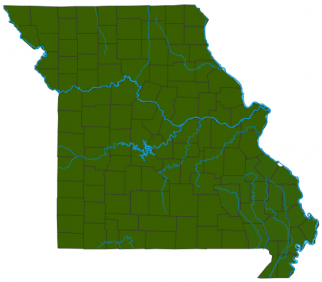
Occurs naturally in the Ozark highlands in southern and east-central Missouri. The overall range is in the Ozark Plateau, in southern Missouri, northwestern Arkansas, and northeastern Oklahoma.
Both of our witch-hazel species are cultivated statewide.
Habitat and Conservation
Occurs in gravel and rocky dry streambeds, at the bases of rocky slopes, and along streams, and rarely on wooded hillsides in rocky draws. It's a characteristic shrub in Ozark highland streams where gravel bars form on moderate to high-gradient streams and rivers, where the soils are deep, well-drained above the water level, and fairly acidic. Flooding is frequent and dramatic in these streamside habitats, and the soils aren't very fertile.
Ozark witch-hazel is widely cultivated statewide, in part for its amazing trait of blooming as early as January, sometimes when snow is on the ground.
Status
Native deciduous shrub. Increasingly popular in landscaping for its attractive but odd-looking early blooms, which add wintertime interest to the landscape.
Human Connections
This species, along with eastern witch-hazel (H. virginiana), has long been used as a source for making witch-hazel extract, used in shaving lotions and ointments for treating bruises, sprains, skin irritations, and more.
Witch-hazel is increasingly used for landscaping and erosion prevention. The Missouri Botanical Garden has selected it as a Plant of Merit, for its outstanding quality and dependable performance for the lower Midwest.
If you are thinking of planting this shrub, obtain the plants from a reputable native plant nursery. Ozark witch-hazel does best in rich, moist, well-drained soils, and it flowers best in full sun. If you don't keep the root suckers trimmed, it will spread and form a colony. Prune it in spring.
Why the name "witch-hazel"? In Middle English, the word wyche meant "yielding" or "pliable" and was used as the name for wych elm (Ulmus glabra), also called wych hazel, a tree with easily bendable twigs. The same common name was eventually transferred to the members of genus Hamamelis.
In the Ozarks and elsewhere, forked switches of this plant and its close relatives have long been used by "witch wigglers" or "water witches" (water finders) to find the best places to dig wells. Missouri's great folklorist Vance Randolph described this fascinating ritual in the Ozarks.
Witch-hazel is often hyphenated or sometimes spelled closed (witchhazel). This helps distinguish this genus, which has its own family, from true hazels, which are in the birch family and are not related. The leaves are similar.
Ecosystem Connections
Deer eat the shoots and leaves. Beaver, squirrels, and rabbits sometimes eat the bark. Turkey and grouse eat the seeds and flowers.
A variety of insects eat the leaves, developing seeds, or other parts, or suck the sap, including beetles, plant bugs, leafhoppers, moth caterpillars, and aphids.
Some species of moths and aphids are specialized to feed on witch-hazels:
- The spiny witch hazel gall aphid (Hamamelistes spinosus) creates round, spiny galls on witch-hazel twigs, as it feeds on the buds. The next generation is scalelike and causes lines of small, lumpy nodules along the leaves of river birch, which is when people usually notice them. This aphid has a two-year life cycle, requiring both host plants.
- The witch hazel cone gall aphid (Hormaphis hamamelidis) creates conical, reddish galls on witch-hazel leaf surfaces; it may also alternate with river birch, similar to the spiny witch hazel gall aphid.
- The witch hazel dagger moth (Acronicta hamamelis) is an ornately marked grayish noctuid moth whose caterpillars chew the leaves of witch-hazel species.
Ozark witch-hazel is one of many interesting plants that live in Ozark stream edge natural communities. It's a dominant and characteristic shrub of gravel washes in the Ozark highlands. Other plants in this natural community include ninebark, swamp dogwood, Ward's willow, water willow, buttonbush, butternut, sand grape, common hop tree, common alder, shrubby St. John's wort, mist flower, shining blue star, Arkansas ironweed, and chairmaker's rush.
Ozark witch-hazel's gravel wash natural community is an important place for many kinds of animals to have access to water. Species include raccoon, Fowler's toad, watersnakes, southern pearly eye, toad bugs, fishing spiders, and many more.
Good grief, what pollinators are around in January to visit these flowers? It only takes a day or two of sunshine and relative warmth to make Ozark witch-hazel burst into bloom, and apparently that's all it takes to awaken gnats, midges, flower flies, and a variety of other flies from winter dormancy, too. They are attracted by the flowers' sweet scent.
